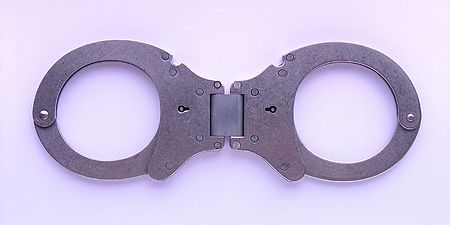Handcuff
Handcuff
A handcuff (or manacles, shackles, fetters, leg cuff, leg irons) is a device that restraints movement of an individual's hands or feet. They are a two piece assembly connected by a chain, hinge, or bar that remain attached to the wrists or ankles through the use of one or more locks. Handcuffs are typically used by law enforcement and military personnel to detain suspects or enemy combatants.
Handcuffs made specifically for use on the ankles are referred to as legcuffs, while those made specifically for fingers are referred to as finger cuffs.
History
Add to me!
Principles of operation
Add to me!
Components
Body
- The handcuff body is a two piece assembly that contains the pawl arm and double lock mechanism. It is attached to the ratchet arm and the use of the key releases the ratchet arm by retracting the pawl arm inside the body. In locks that use more advanced lock mecahnisms, the body is often used to store the lock cylinder and pawl arm actuator components. The body may also be referred to as the shroud, cheek plates, or double strand.
Pawl arm
- The detainer arm of the handcuff, located inside the cuff body. Proper use of a key will retract this arm away from the ratchet arm, allowing the cuffs to open.
Ratchet arm
- The swivelling arm of the handcuff that is connected to the cuff body. Proper use of a key will allow the cuffs to open by freeing ratchet arm from the cuff body.
Keyway
- The entry point of the key which includes a key post. The key post centers the key and provides a stable position to rotate the key and actuate the pawl arm and double-lock mechanisms.
Double-lock
- a small pin or sliding bar on the body of the cuff. Once engaged, the double lock prevents the pawl arm from moving until it the double lock is released. Most cuffs will set the double lock using a protrusion on the end of the key and unlock the double lock by turning the key counter-clockwise in the keyway. The double lock exists both as a security and safety mechanism.
Rivets
- Rivets are commonly used to hold the body of the cuff together. They must be destructively removed to separate the body of the handcuff.
Swivel
- In cuffs that allow rotation of the wrists or ankles, the swivel is the rotating piece on each cuff that connects to the chain, hinge, or bar which hold the cuffs together.
Linkage
- The linkage is the bridge between the two cuffs, often in the form of a chain, hinge, or bar. In more advanced locks the linkage may be where the lock components are located.
Gallery
A pair of handcuffs with an ASSA Desmo lock.
Vulnerabilities
In film and televsion, handcuffs are commonly opened by people from all walks of life, often with the use of improvised tools. In the real world, traditional cuffs are commonly opened by picking or shimming the ratchet mechanism. Handcuffs may be vulnerable to one or more of the following:


